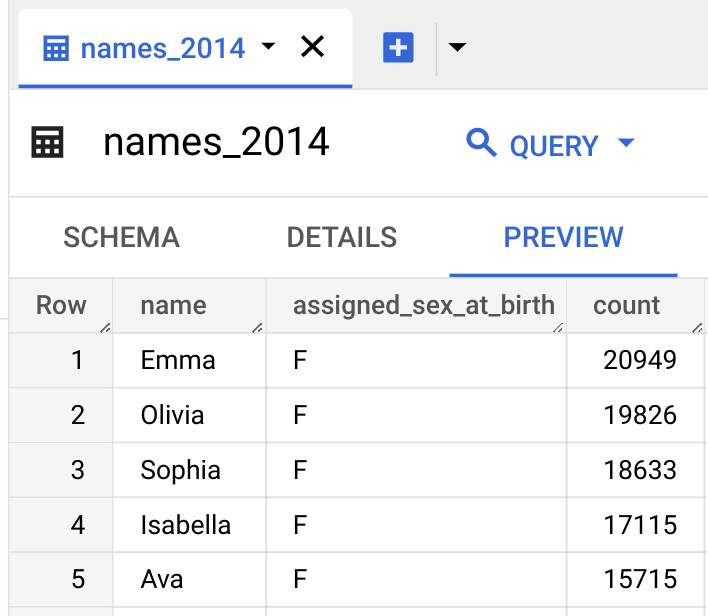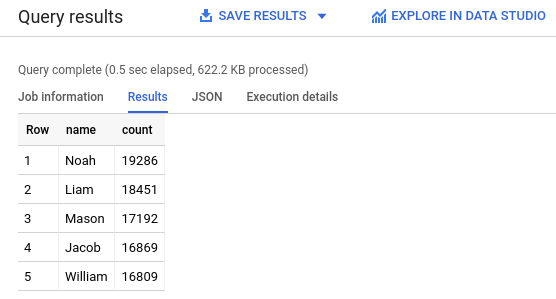Load and query data with the Google Cloud console
Learn how to use the Google Cloud console to create a dataset, load sample data into a BigQuery table, and query tables.
To follow step-by-step guidance for this task directly in the Google Cloud console, click Guide me:
Before you begin
Before you can explore BigQuery, you must log in to Google Cloud console and create a project. If you don't enable billing in your project, then all of the data you upload will be in the BigQuery sandbox. The sandbox makes it possible for you to learn BigQuery at no charge while working with a limited set of BigQuery features. For more information, see Enable the BigQuery sandbox.- Sign in to your Google Cloud account. If you're new to Google Cloud, create an account to evaluate how our products perform in real-world scenarios. New customers also get $300 in free credits to run, test, and deploy workloads.
-
In the Google Cloud console, on the project selector page, select or create a Google Cloud project.
-
In the Google Cloud console, on the project selector page, select or create a Google Cloud project.
- Optional: If you select an existing project, make sure that you enable the BigQuery API. The BigQuery API is automatically enabled in new projects.
Create a BigQuery dataset
Use the Google Cloud console to create a dataset that stores the data.
- In the Google Cloud console, open the BigQuery page. Go to BigQuery
- In the
Explorer panel, click your project name. - Expand the View actions > Create dataset.
- On the Create dataset page, do the following:
- For
Dataset ID, enter
babynames. - From the Data location list, choose us (multiple regions in United States).
The public datasets are stored in the
usmulti-region location. For simplicity, store your dataset in the same location. - Leave the remaining default settings as they are, and click
Create dataset .
Download the source data file
The file that you're downloading contains approximately 7 MB of data about popular baby names. It's provided by the US Social Security Administration.For more information about the dataset, see the Social Security Administration's dataset information page.
Download the US Social Security Administration's dataset by opening the following URL in a new browser tab:
https://www.ssa.gov/OACT/babynames/names.zipExtract the file.
For more information about the dataset schema, see the zip file's
NationalReadMe.pdffile.To see what the data looks like, open the
yob2014.txtfile. This file contains comma-separated values for name, assigned sex at birth, and number of children with that name. The file has no header row.Note the location of the
yob2014.txtfile so that you can find it later.
Load data into a table
Next, load the data into a new table.
- In the
Explorer panel, click your project name. - Next to the babynames dataset, click More actions and select Open.
- In the details panel, click
Create
table.
Unless otherwise indicated, use the default values for all settings.
- On the Create table page, do the following:
- In the Source section, choose Upload from the
Create table from list. - In the Select file field, click Browse.
- Navigate to and open your local
yob2014.txtfile, and click Open. - From the
File format list, choose CSV - In the Destination section, enter
names_2014forTable name . - In the Schema section, click the
Edit as text toggle, and paste the following schema definition into the text field: Click
Create table .Wait for BigQuery to create the table and load the data. When BigQuery finishes loading the data, expand the
Personal history and Project history panel to review the job details.
name:string,assigned_sex_at_birth:string,count:integerPreview table data
To preview the table data, follow these steps:
- In the
Explorer panel, expand your project andbabynamesdataset, and then select thenames_2014table. - In the details panel, click
Preview . BigQuery displays the first few rows of the table.

Query table data
Next, query the table. The process is identical to the previous example, except that this time, you're querying your table instead of a public table.
- Click Compose new query. A new Editor tab opens.
- In the
Editor tab , paste the following query. This query retrieves the top five names for US babies that were assigned male at birth in 2014.
SELECT name, count FROM `babynames.names_2014` WHERE assigned_sex_at_birth = 'M' ORDER BY count DESC LIMIT 5; - Click
Run . The results are displayed in the Query results section.

You have successfully queried a table in a public dataset and then loaded your sample data into BigQuery using the Cloud console.
Clean up
To avoid incurring charges to your Google Cloud account for the resources used on this page, follow these steps.
- In the Google Cloud console, open the BigQuery page. Go to BigQuery
- In the Explorer panel, click the
babynamesdataset that you created. - Expand the View actions option and click Delete.
- In the Delete dataset dialog, confirm the delete command: type the word
deleteand then click Delete.
What's next
- To learn more about using the Google Cloud console, see Using the Google Cloud console.
- To learn more about loading data into BigQuery, see Introduction to loading data.
- To learn more about querying data, see Overview of querying BigQuery data.
- To learn how to load a JSON file with nested and repeated data, see Loading nested and repeated JSON data.
- To learn more about accessing BigQuery programmatically, see the REST API reference or the BigQuery client libraries page.
